Boarding Trains in China Just Got a Lot Easier for Foreigners

Good news for frequent train travelers in China: You no longer need paper tickets at select train stations across the country!
High-speed train stations are beginning to eliminate paper tickets as China’s massive railway network transfers to a digital ticketing system.
The new e-ticket exclusive program was launched in two phases late last month at nearly 100 stations around the Yangtze River Delta, including major transportation hub Shanghai Hongqiao Railway Station. Electronic ticketing service is also being offered at select intercity lines, including the Beijing-Shanghai route. The Guangzhou-Shenzhen route now also operates its own separate paperless ticketing.
READ MORE: Here’s How to Travel Ticket-Free on the Guangzhou-Shenzhen Train
Xinhua reports that the paperless system is currently being piloted and will gradually be rolled out nationwide. According to the Shanghai Railway Bureau, the plan is to cover all high-speed rail lines and EMU train stops at stations within the region by mid-December 2019. Trial runs started on the Shanghai-Nanjing high-speed train in July, and nearly 19 million e-tickets were sold by the end of October. The program was also piloted in Hainan starting in 2018.
The new system aims to reduce ticket fraud and enhance the overall quality of service. No doubt it will also save tons of time when you’re on a tight schedule and can’t afford to wait in the ticket pick-up line. Likewise, it cuts down on problems created by losing or forgetting your ticket.
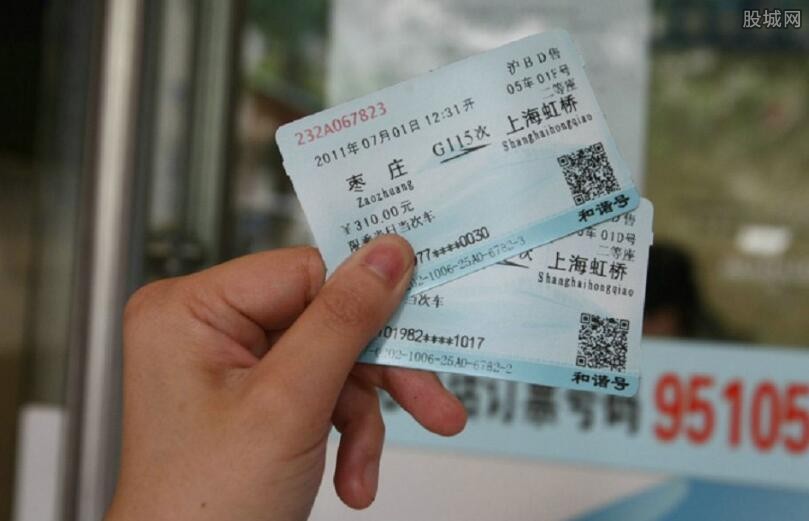
Zaijian, blue tickets. Image via Gucheng
Currently, the paperless ticketing system is only available for high-speed trains (G, D). The old ticketing system still applies for regular trains (Z, T, K).
Hop aboard our step-by-step guide to taking the bullet train on the new paperless ticketing system...
Step 1: Book Your Train Tickets
To get started, book train tickets like you normally do. We recommend the official China Railway website (12306.cn) or the English-language Trip.com. Both platforms also offer mobile apps.
Other third-party apps, such as train booking Mini Programs offered on Alipay and WeChat, also work. You can also book seats directly at the train station’s main ticketing windows.
E-ticket information will be linked to your original valid ID used at purchase.
Optional: Get Your E-Ticket QR Code on 12306
You can use the 12306 mobile app to get an e-ticket QR code sent straight to your phone. To register, download the 12306 app and complete the facial recognition verification step, which should take around two to three business days to confirm. To complete this step, you’ll need to upload two photos: a clear photo of your ID, and another photo of you holding the ID (full face included).

To verify your identity, go to 我的 > 认证核验 and then upload your photos. Screengrab by That’s
If you’re registering for a 12306 account for the first time, you’ll also need to enter in your standard ID information (for Chinese mainland, Hong Kong, Macao and Taiwan citizens) or passport info (foreigners), along with your local phone number.
Once your 12306 account is confirmed and your identity verified, the 12306 app will generate a QR code for each booked journey. You can use this QR code for ticket checks or for entering the station and passing through the Manual Channel (more on that in Step 3). You can also use it to print out your own physical copy of the ticket for personal records.
For foreigners, this step isn’t really necessary, as the only machines that accept e-ticket QR codes for boarding trains also accept passports.
Note that both the 12306 website and app are only available in Chinese.
Step 2: Enter the Train Station
Once your train tickets are booked, head to the station’s main entrance and present your passport or valid ID at the identity check desk. Then you’ll pass through security before making your way to the platform.
If you’d still like to pick up a ticket stub for reimbursement purposes, or to have on hand just in case, you can do that at the ticketing windows. The physical tickets will no longer list your seat number, and instead you will receive a separate paper receipt with trip info.
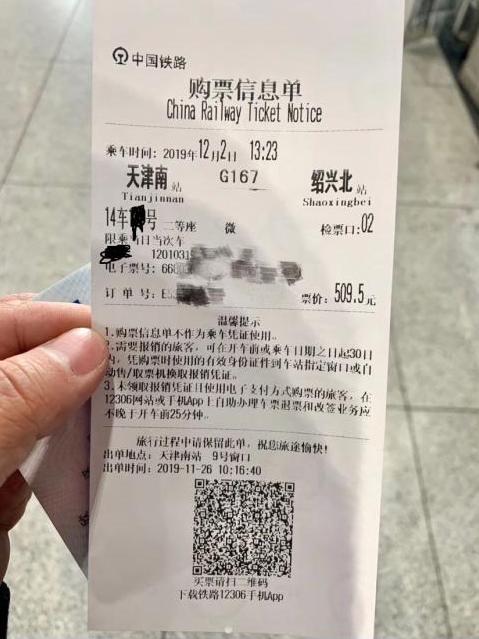
Image via The Paper
Note that the above process only applies to stations that have implemented the digital-only ticketing system. Other stations may have temporary entrance and ticket collection procedures in place while the system is rolled out nationwide. Ticket collection procedures may vary by station; contact railway staff for more information.
Step 3: Board the Train
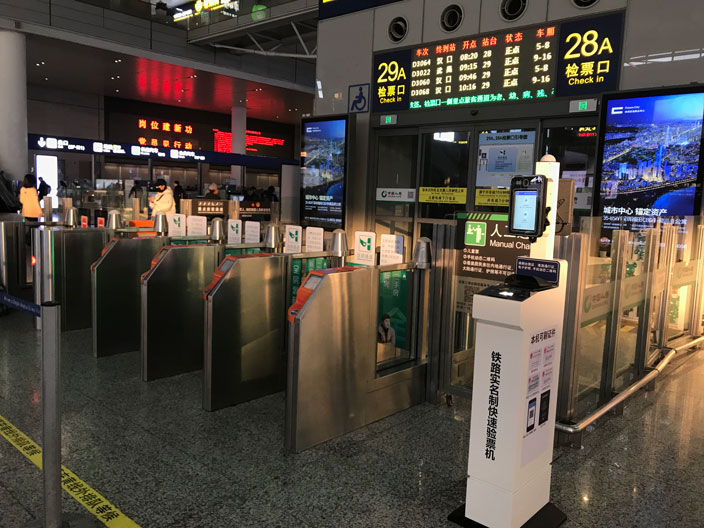
The new ticketing gates at Shanghai Hongqiao station. Image by Bridget O’Donnell/That’s
When it comes time to board, show up to the platform gate to scan your ID. Foreign passport holders and residents of Hong Kong, Macao and Taiwan with Chinese mainland travel permits will be directed to a Manual Channel (人工通道) to have their identification scanned by a railway staffer.

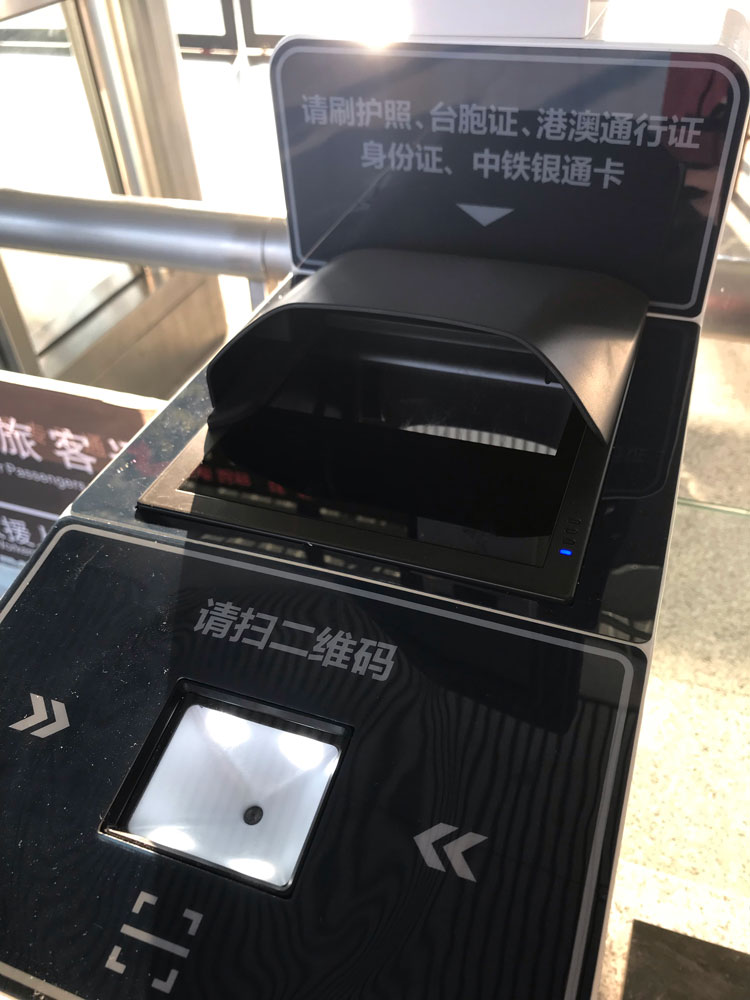
Images by Bridget O’Donnell/That’s
Chinese citizens, foreign permanent residents and Hong Kong/Macao/Taiwan residence permit holders can use the Self-Service Channel (自助通道). Here, you’ll simply scan your ID card at the turnstile to automatically enter the platform.
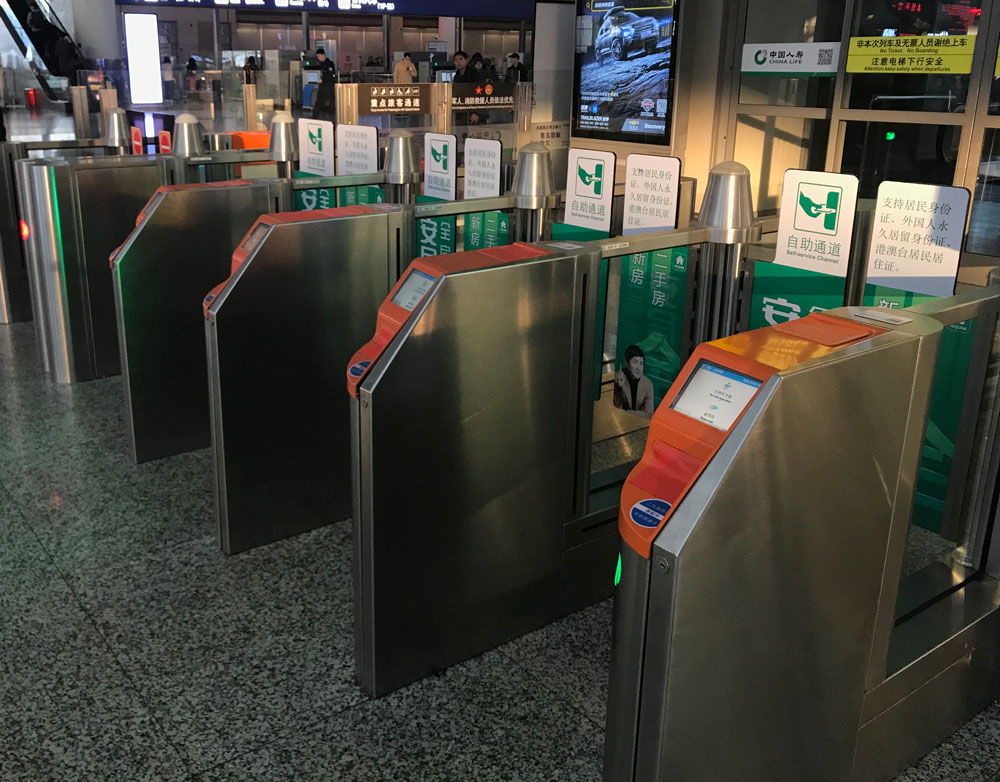
Image by Bridget O’Donnell/That’s
At railway stations using the digital-only ticketing system, you’ll no longer be able to insert paper tickets into the platform turnstiles. The machines have been sealed off and no longer accept them.
READ MORE: High-Speed Trains Now Have Food Delivery, Here’s How to Order
Step 4: Arrive at Your Destination
Upon exiting the platform at your arrival station, your ID will be scanned at a second checkpoint. To exit, head to the Manual Channel or Self-Service Channel and scan your passport or identification card.
E-Ticket Train Stations
Here are the 45 first-phase stations currently offering digital-only ticketing:
Nanjing South
Quanjiao
Hefei
Lu’an
Jinzhai
Bengbu South
Huainan East
Shuijia Lake
Hefei Beicheng
Hefei South
Changlin River
Chaohu East
Wuwei
Tongling North
Nanling
Qu County
Jingde
Jixi North
Shexian North
Huangshan North
Jiangning
Jurong West
Lishui
Wawushan
Liyang
Yixing
Changxing
Huzhou
Deqing
Anqing
Chizhou
Tongling
Fanchang West
Qujiang
Wuhu
Dangtu East
Ma’an Shandong
Jiangning West
Hangzhou East
Fuyang
Tonglu
Jiande
Qiandao Lake
Sanyang
Hangzhou
And here are the 48 second-phase stations currently offering digital-only ticketing:
Ningbo
Fenghua
Ninghai
Sanmen County
Linhai
Taizhou
Wenling
Yandangshan
Shenfang
Yueqing
Yongjia
Wenzhou South
Rui’an
Pingyang
Cangnan
Songjiang South
Jinshan North
Jiashan South
Jiaxing South
Tongxiang
Haining West
Yuhang
Shaoxing North
Shaoxing East
Yuyao North
Zhuangqiao
Zhuji
Yiwu
Jinhua
Longyou
Yinzhou
Jiangshan
Jinhua South
Wuyi North
Yongkang South
Jinyun West
Lishui
Qingtian
Yancheng North
Sheyang
Funing East
Binhai Port
Xiangshui County
Lianyungang
Ganyu
Huaibei
Huaibei North
A selection of other stations that are piloting or have implemented the system:
Beijing South
Tianjin West
Tianjin South
Langfang
Cangzhou West
Dezhou East
Zhengzhou
Zhengzhou East
Xi’an North
Weinan North
Dali
Kunming
Lijiang
Here are the intercity lines currently trialing a paperless ticketing system:
Beijing South–Shanghai Hongqiao
Beijing–Xiong’an
Chengdu–Chongqing
Guangzhou–Zhuhai (Zhanjiang West Line)
Kunming–Dali–Lijiang
Hainan Roundabout Railway
The list of participating stations and lines will constantly change as the paperless ticketing system is implemented nationally. Stay tuned to Thatsmags.com for the latest updates.
[Cover image via Enzo Jiang/Flickr]
Last updated December 5, 2019
Get the weekly newsletter!
Sign up to get the entertainment, lifestyle and event news from Urban Family every week!Classified Posts
News























